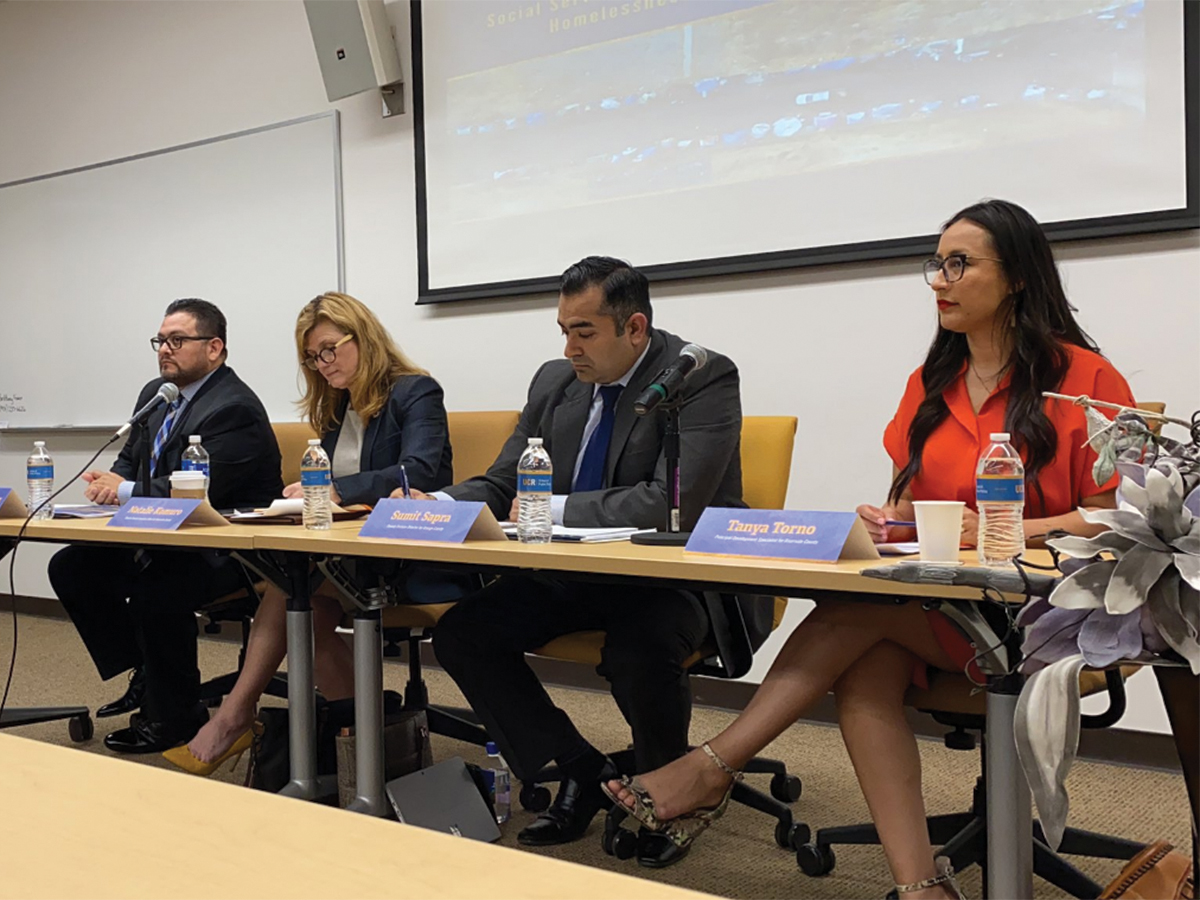As homelessness rises in Southern California, the Dean’s Brand Ambassadors and UCR’s School of Public Policy (SPP) hosted a panel of policy practitioners from various social services agencies across Southern California to discuss what can be done about the issue.
The panel, held on March 4, was comprised of Armando Gonzalez, a human services administrator for the County of Los Angeles, Natalie Komuro, the deputy county executive officer, Tanya Torno, the principal development specialist for the County of Riverside and Sumit Sapra, deputy division director for Orange County.
They each led the discussion by introducing the work that they have been doing in their respective cities. Gonzales has been working with the county of Los Angeles for 16 years analyzing and interpreting new and revised policy related to healthcare reform and currently serves over 3 million individuals in the Medi-Cal program. Komuro has worked within the nonprofit sector planning programs for the homelessness and implementing policies being made federally and locally. She stated, “we are in a really oportun moment in Riverside County because the (homelessness) numbers may not be as large as Los Angeles but the intensity of the problem is no different so what we have to do is substantially the same.” Sapra overseas regional and divisional operations such as CalWORKs and Refugee Cash Assistance, Welfare-To-Work and Foster Care Eligibility programs while Torno is part of a team that works to support individuals that experience homelessness.
Komuro stated that there is a severe undercount in the number of individuals that are reported homeless, because homelessness can present itself in different ways. For example, homeless families who overcrowd houses are undercounted while African Americans are overrepresented because they have a higher representation in shelters. According to the 2019 Annual Homeless Assessment Report (AHAR) to Congress, there are currently 151,278 homeless individuals in California, those of which 108,432 are unsheltered. In Riverside County, 27% of the unsheltered population is Hispanic and 54% are white, stated Komuro. Gonzalez stated that these numbers are very similar to those in L.A. County and according to Sapra, the number of unsheltered men are the highest compromised group in Orange County at 71%.
Torno stated that one of the main causes of homelessness is inaccessibility to affordable housing, “for Riverside … more than 50% of people that are currently in housing are paying more than 50% of their income toward rent.” Gonzales stated that there is not one set cause for homelessness and it can affect anyone. When the 2008 recession hit, “we started seeing individuals with Ph.D. degrees, engineers from all levels of economic and educational backgrounds (seeking homeless assistance),” stated Gonzalez.

The panelists also addressed myths and misconceptions pertaining to homelessness in the country. “Well they are not all drug addicts,” stated Komuro, “addiction is a real thing but perception does not equal fact.” She stated that for every homeless person seen that is affected by addiction, “there are hundreds of others that you never see.” Torno addressed the racial disparities in Riverside County stating, “when we look at who we are serving in our shelters it is a very different reflection of those that would not meet Housing and Urban Developments (HUD) standards of homelessness.” In Riverside County, according to Torno, 67% of people experiencing homelessness are white and only 26% are black. The racial disparity comes from comparing the data of who actually lives in Riverside County. It does not take into account the families of color who are doubling up in homes making them ineligible to receive the resources HUD provides because they are not living in the streets or in shelters, stated Torno.
In response to the effectiveness of arresting homeless individuals, the panelists’ views aligned. “It’s not very effective, it also adds to the list of violations they may have on their record,” stated Komuro. According to Komuro, it is much more cost effective to provide interventions to homelessness rather than arrest them.
After the panel, The Highlander spoke to all four panelists about their views on the current state of the homelessness issue in Southern California. Gonzalez stated that people having access to healthcare will address some of the issues homeless individuals are currently experiencing and that the current stigma comes down to a lack of awareness on the homeless crisis.
Sapra stated that he has certainly seen improvement to the issue in the time he has worked in Orange County. “We definitely recognize in Orange County that it is not just one agency or department that can do it alone,” he stated.
Torno spoke to the cost of living adjustment (COLA) strikes happening across the UC system stating that she believes there is power in protest. “We’ve had affordable city developments … that would allow for people to quickly regain housing but because of a collective group that says no, those projects have been turned down,” stated Torno. Therefore, she believes “there is absolute value in collective groups coming together to champion a cause.”
“There has been growing dogma about what approach is the right approach,” stated Komuro. She stated that this has been harmful to policy because the qualifications of what characterizes someone as homeless are too specific. To college students looking to get involved in the same field, Korumo stated the most important thing to do is always ask questions. “When presented with a policy, always ask why … If you can’t explain the rationale behind a policy then maybe we don’t need it,” she said.
Gonzalez stated, “We have to change what the definition of homelessness is,” and he acknowledged that the agencies they work for and HUD are the drivers of such change.








